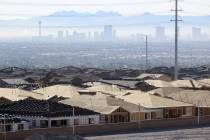Report: Las Vegas hits new post-peak housing low
WASHINGTON — Residential real estate prices dropped more than forecast during the year ended Sept. 30, showing the industry at the center of the 2008 financial crisis continues to struggle.
The S&P/Case-Shiller index of property values in 20 cities dropped 3.6 percent in September from the same month in 2010 after decreasing 3.8 percent in the year ended August, the group reported Tuesday in New York. The median forecast of 32 economists in a Bloomberg News survey had projected a 3 percent decrease.
Atlanta, Las Vegas and Phoenix posted new post-peak lows in September, the report showed.
Las Vegas-based housing research firm SalesTraq reported a median existing-home price of $104,900 in September, a decrease of 10.9 percent from the same month a year ago. It was up from $103,500 in August. The median price remain unchanged in October.
“Yes, prices could continue to decline next year, but not by much, probably less than 5 (percent) to 10 percent,” SalesTraq President Larry Murphy said. “Savvy investors will continue to buy Las Vegas real estate because they realize that our market is currently overcorrected and undervalued.”
Unemployment at 9 percent, tight lending standards and a looming supply of distressed properties that may drag down home values further will probably keep hurting housing demand into next year. Sliding prices have left some people with loans that exceed the value of their properties, preventing them from boosting spending on other goods and services.
“We continue to expect home prices to fall through mid-2012,” said Anika Khan, an economist at Wells Fargo Securities in Charlotte, N.C. “We still have an oversupply of existing homes, and distressed transactions continue to drive down home prices.”
Estimates in the Bloomberg News survey for the price change ranged from declines of 2.7 percent to 3.9 percent. The Case-Shiller index is based on a three-month average, which means the September data were influenced by transactions in July and August.
The year-over-year decline in September was the smallest in seven months.
Home prices adjusted for seasonal variations fell 0.6 percent in September from the prior month, the biggest decrease since March, after falling
0.3 percent in August. Unadjusted prices also decreased 0.6 percent from August as 17 of 20 cities showed declines. Only Washington, New York and Portland, Ore., showed gains.
The year-over-year gauge provides better indications of trends in prices, according to the S&P/Case-Shiller group. The panel includes Karl Case and Robert Shiller, the economists who created the index.
Eighteen of the 20 cities in the index showed a year-over-year decline, led by a 9.8 percent drop in Atlanta.
Detroit showed the biggest year-over-year increase, with prices rising 3.7 percent in the 12 months to September. Property values in Washington were up 1 percent.
Nationally, prices decreased 3.9 percent in the third quarter from the same time in 2010. They increased 0.1 percent from the previous three months before seasonal adjustment and dropped 1.2 percent after taking those changes into account.
A pipeline of seized properties threatens to weigh on prices even more as a temporary halt on foreclosures stemming from faulty seizures comes to an end. In the third quarter, U.S. lenders started foreclosures on more homes, the first increase in a year, as bank moratoriums that clogged the pipeline abated.
Las Vegas Review-Journal writer Hubble Smith contributed to this report.


















